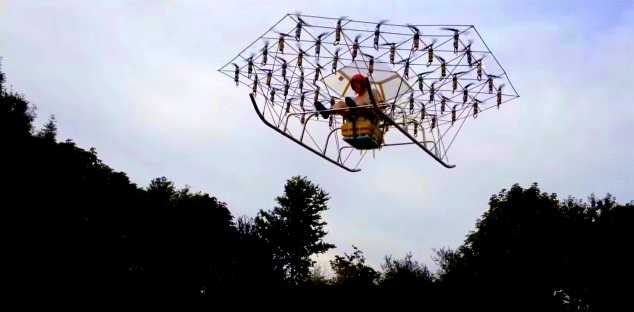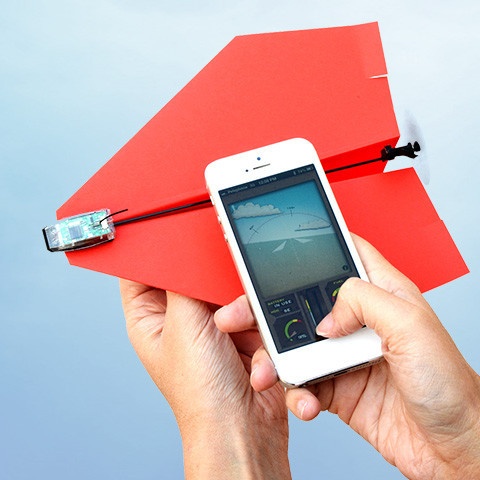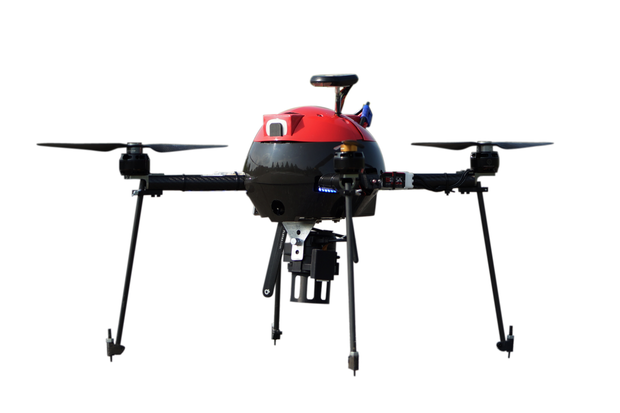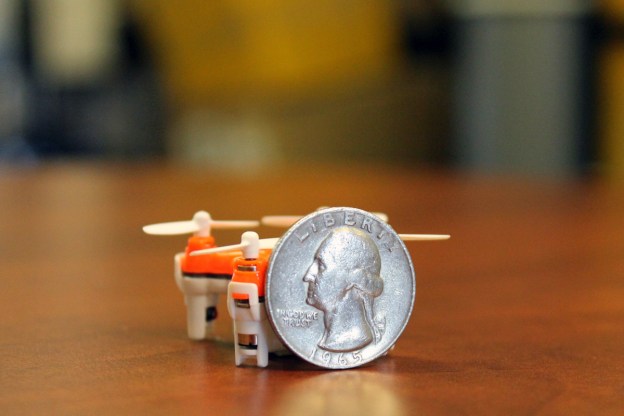New Product
The Swarm: Man carrying multi-rotor. NOT a UAV
by Gary Mortimer

I will just park this here…
The Swarm man carrying multi-rotor airborne flight testing montage. 54 counter-rotation propellers, six grouped control channels with Hobbyking stabilization. Take of weight 148kg, max lift, max approx. lift 164kg. Endurance10 minutes.
Last years test flight.
https://youtu.be/1qlfAMjcPtI
http://www.suasnews.com/2015/08/38169/the-swarm/
Feds approve paper airplane drone flights

By Keith Laing
The Federal Aviation Administration (FAA) has approved the use of a paper airplane that is a drone.
The agency issued the approval for flights of a drone that is described as a “smartphone-controlled paper airplane.” In doing so, it waived requirements for FAA approval of drone flights that are operated outside of restricted airspace and below 200 feet.
The agency said the flights were approved for “aerial photography and videography” purposes.
The makers of the paper airplane drone, Connecticut-based Tailor Toys PowerUp, tout the paper airplane drones as a revolutionary product.
“The PowerUp 3.0 transforms ordinary paper planes into smartphone-controlled flying machines,” the company says about the devices on its website.
“Simply tilt your smartphone or tablet to maneuver right or left and use PowerUp’s throttle lever to ascend or descend,” the description continues. “The motorized frame’s 180 feet/ 55 meter range, crash-resistant design, and responsive motion control and precision turning give users extremely flexible flight control.”
The FAA has approved more than 1,000 drone flights in the process of developing regulations for allowing a rapid expansion of the use of the devices in the U.S.
The agency has faced tremendous pressure to approve an expansion of nonmilitary drone use from companies such as Amazon, which has said the technology can be used to make speedier online deliveries.
Police and other law enforcement groups were also seeking approval to use the technology, and the FAA has investigated several drone incidents that occurred in conjunction with photography at college and professional sporting events.
The section of law that allows the FAA to grant drone exemptions gives the Transportation Department the authority to drop a requirement that operators of the technology apply for a certificate of airworthiness that is normally required for flights that are formally considered an aircraft.
In its letter to the paper airplane drone petitioner, Connecticut resident Peter Sachs, the FAA said it “has determined that good cause exists for not publishing a summary of the petition in the Federal Register because the requested exemption would not set a precedent, and any delay in acting on this petition would be detrimental to the petitioner.’
The definition of drones as aircraft under the FAA’s proposed rules has riled recreational operators of the devices who consider themselves hobbyists instead of pilots.
The FAA’s rules define small drones as devices that weigh less than 55 pounds and require them to be operated at heights that are less than 500 feet and speeds that are less than 100 miles per hour.
The regulations also call for drone flights to be limited to daytime hours and conducted only by U.S. residents who are older than 17.
Drone operators are also prohibited under the FAA proposal from conducting flights that take the devices out of their line of vision — a big blow to companies like Amazon that have touted the possibility of using the technology to conduct deliveries.
http://thehill.com/policy/transportation/252141-feds-approve-paper-airplane-drone-flights
Sony’s quadcopter takes smartphone tech to the skies
Aerosense drone
A drone developed by Sony’s unmanned aerial vehicle venture Aerosense is seen in a promo image. The startup wil target enterprise users in everything from farming to construction from 2016. Credit: Aerosense
Equipped with a high-speed data transfer module, the quadcopter uses Sony’s lens-style camera to image construction sites and farms.
By Tim Hornyak
IDG News Service | Aug 24, 2015
Sony is gunning for a slice of the growing drone market, showing off newly developed unmanned aerial vehicles (UAVs) from its just-launched drone venture, Aerosense.
In addition to the vertical takeoff and landing (VTOL) craft hinted at last month, Aerosense on Monday exhibited a quadcopter that makes use of Sony’s lens-type camera, the QX30.
The camera, which resembles a lens for a digital single-lens reflex (DSLR) camera and can link to smartphones, is attached to the belly of the quadcopter, where it can take high-resolution images.
Designed for use in urban areas such as construction zones, the AS-MC01-P quadcopter weighs about 3 kilograms (6.6 pounds) and can fly for about 15 to 20 minutes on a battery charge.
It can operate autonomously, flying within a preset zone, and is equipped with GPS, Wi-Fi and an inertial navigation system. It also has a high-speed data transfer module that uses Sony’s TransferJet technology.
In a presentation in Tokyo, Aerosense showed how photography from the camera can be turned into 3D imagery, showing, for instance, the volumes of piles of gravel at a construction site.
The venture’s other craft, the AS-DT01-E winged VTOL drone, has a rotor system that allows it to fly like a helicopter or a plane. The advantage of the winged format is that it can fly at much higher speeds than most non-military drones — up to 170 kilometers per hour (106 miles/hour) compared to high-speed quadcopters that fly at 75 kph (47 mph).
Weighing 7kg (15 pounds), it can carry a 3kg payload (6.6 pounds) and operate for at least two hours on a battery charge.
Aerosense will target enterprise customers when it begins to offer drones for monitoring, surveying and inspection next year.
Potential applications include photographing agricultural land, mining sites and mountainous areas to check for damage after a storm.
Sony wants to use its smartphone technologies such as cameras and networking know-how to give Aerosense an edge. Sony Mobile Communications owns just over 50% of the venture, with the rest in the hands of Tokyo robotics firm ZMP, which set up a robot taxi company earlier this year along with mobile gaming giant DeNA.
Sony also has robotics resources that it is putting into the drone business. Aerosense’s CTO is Kotaro Sabe, who worked on the electronics maker’s Aibo robot dog and Qrio humanoid robot, both of which were shelved when Sony shut down its entertainment robot business about 10 years ago.
Sony’s Xperia smartphones have been struggling in Japan and overseas against the more popular Apple iPhone as well as Android rivals.
“It’s possible that future growth in smartphones could be limited, so we have to engage and invest in new business opportunities,” said Hiroki Totoki, head of Sony Mobile Communications.
http://www.computerworld.com/article/2975016/emerging-technology/sonys-quadcopter-takes-its-smartphone-tech-to-the-skies.html
SAR – Search and Rescue Drone Tayzu Titan X8 – 20X Optical Zoom and Thermal FLIR Camera
Aerial photo comparison, Sony A7RII vs Sony Rx100 vs DJI Fc350
DJI Watersports?
Launch of silent drone aims to advance the film industry
MEGHAN LAWRENCE/FAIRFAX NZ

Howick brothers Mat Rowe and Seamus Rowe with the beginnings of their drone design. The third brother Shaun Pentecost, 35, who couldn’t make it along for the photo, is looking after the drone’s coding.
Three inventive brothers have been awarded $10,000 to design a new drone that could revolutionise the film industry.
Seamus and Mat Rowe and their brother Shaun Pentecost, all from Howick in East Auckland, are one of six teams to make the finals of the 2015 Callaghan Innovation C-PRIZE competition.
The competition is centred around producing the next generation of unmanned aerial vehicle (UAV) technology that can be used in big screen productions.

Seamus Rowe soldering together parts of the drone.
The brothers decided to take on the challenge of creating a drone that could not only film, but also record spoken dialogue with very little unwanted noise.
They hope their combined experience in electrical engineering and biotechnology will help them produce a marketable drone.
Seamus, 22, says there are a lot of drones already on the market, but the sound they make is horrible.
“The whole goal of this project is to try and make the drone quieter,” the Manukau Institute of Technology electrical engineering student says.
“At the moment the sound they produce is about 80 decibels, which is like shouting, so you can’t record audio from them at all because they are way too noisy.”
Mat, 39, says it is not about building a drone from scratch, but trying to create technology that will improve them.
“There are a number of ways of doing that but we have chosen the paths of active noise cancelling and actually making the drones themselves quieter,” he says.
Ad Feedback
The design includes 3D printed shrouding which will muffle the sound of the propellers, as well as technology that will record dialogue while removing any unwanted noise.
The brothers have four months to complete their prototype and are competing for the chance to win $50,000 and a trip to exhibit at the NAB trade show in Las Vegas.
The winners will also receive support from Callaghan Innovation and New Zealand Trade and Enterprise to release the drone on the international market.
It has also been a great way to launch their own technology discovery business, Dotterel Technologies, Mat says.
“It has been good to be given a start. If we were to win we would push it more towards a commercial product and look to expand into other industries such as agriculture,” Mat says.
The winner of the C-PRIZE competition will be announced in late November.
Go to cprize.nz for more information.
http://www.stuff.co.nz/technology/gadgets/71243859/launch-of-silent-drone-aims-to-advance-the-film-industry
Why people are angry with DJI for launch of Phantom 3.
Ouch…
The world’s smallest drone gets ready to take flight
 Image Source: Axis Drones
Image Source: Axis DronesDrones have gone from geeky dream to mainstream gadget in a shockingly brief amount of time. The remote-controlled airborne devices were once expensive tools reserved for businesses with a real need for them. Construction companies, for example, used them to survey and film sites, while video companies used them to capture aerial footage at a fraction of the cost of renting a helicopter.
Today, you can walk into any toy store, spend less than $50 and leave with a recreational drone in your shopping bag.
Drones have flooded the market to the point that it’s getting difficult to distinguish between them, but one company is getting ready to launch a drone that you won’t soon forget: Meet the world’s smallest quadcopter.
Crowdfunded products often fail to actually make it to release, but the Aerius drone by Axis Drones was successfully funded some time ago. It is now less than a month away from launch, and production has apparently gone so well that the device can still be preordered for delivery ahead of the holidays.
How small is the world’s smallest quadcopter drone? As you can see in the photo below, it’s not even as tall as a quarter standing on its edge.

Here are some of the Aerius drone’s key features, as listed on the Axis Drones website:
- The NEW World’s Smallest Quadcopter ® – 3cm x 3cm x 2cm
- Ultra-Compact 2.4 gHz Controller with Drone Storage/Transport Compartment
- 5-7 Minute Flight Time per 15 Minute Charge via USB Cable; 3.7v 80mAh Battery
- 2-Speeds Pre-programmed for Desired Level of Flight Sensitivity
- Headless Mode Allows for Beginners to Ensure Flight Orientation
- 6-Axis Gyro-Stabilization Keeps Drone Stable and Centered
- 360 Degree Rotational Yaw Allows Users to Seamlessly Adjust Orientation
- Pre-programmed “Trick-Mode” Algorithm Provides Amazing Flips and Rolls!
- Bright LED Colored Lights for Night Flight and Drone Orientation
- Available in 4 Color Choices and Controller Accents
- Super Portable, Fun, Unique and a Great way to Practice Flying Drones Indoors!
The Aerius is so small and portable that it can actually be docked inside the remote controller when it’s not being flown.

Here’s a video of the drone in action, and you can also see it doing some flip tricks:
The Aerius drone is set to start shipping on September 30th, and it costs $35 to preorder on Axis Drones’ website.
http://bgr.com/2015/08/18/drone-for-sale-worlds-smallest-aerius/